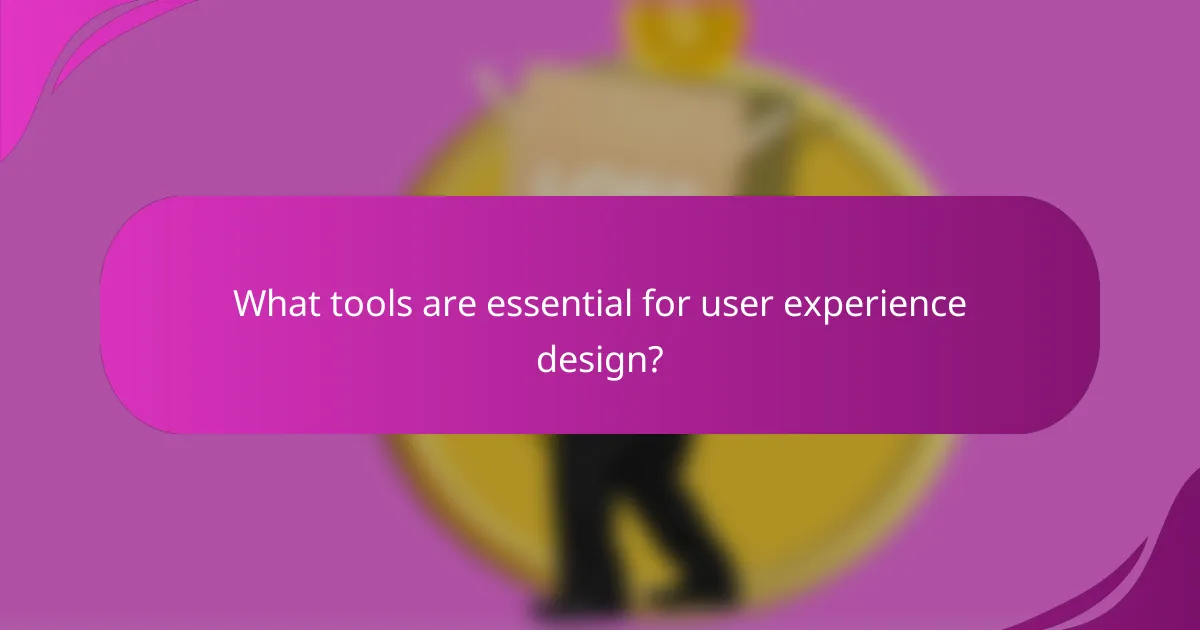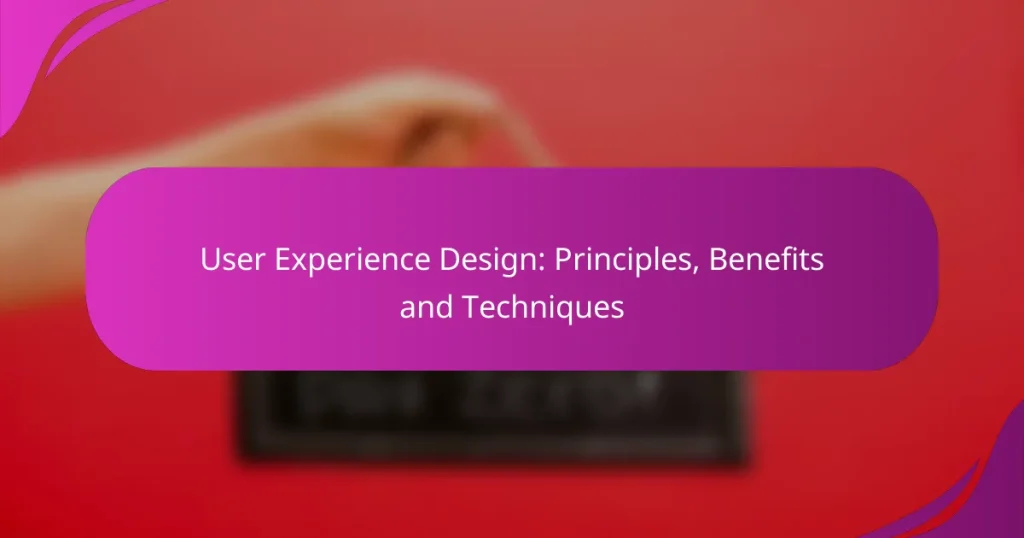User experience design is essential for creating products that are not only functional but also enjoyable and efficient for users. By adhering to key principles and employing various techniques such as user research and prototyping, designers can significantly enhance customer satisfaction and engagement. This focus on usability and accessibility ultimately leads to more effective products that resonate with target audiences, particularly in dynamic markets like South Africa.

What are the key principles of user experience design?
The key principles of user experience design focus on creating products that are easy to use, efficient, and enjoyable for users. These principles guide designers in crafting interfaces that meet user needs while enhancing overall satisfaction.
User-centered design
User-centered design (UCD) prioritizes the needs, preferences, and behaviors of users throughout the design process. This approach involves engaging users in research and testing to gather feedback, ensuring that the final product aligns with their expectations. Techniques such as user interviews, surveys, and usability testing are essential in UCD.
To implement UCD effectively, involve users early and often. Create personas representing different user types to guide design decisions, and iterate based on user feedback to refine the product continuously.
Usability
Usability refers to how easily users can interact with a product to achieve their goals. A usable design minimizes confusion and frustration, allowing users to navigate efficiently. Key factors include learnability, efficiency, memorability, error prevention, and satisfaction.
To enhance usability, conduct usability testing with real users to identify pain points. Focus on intuitive navigation, clear labeling, and responsive design to ensure users can accomplish tasks without unnecessary obstacles.
Accessibility
Accessibility ensures that products are usable by people with diverse abilities and disabilities. This principle involves designing for various needs, including visual, auditory, and motor impairments. Adhering to accessibility standards, such as the Web Content Accessibility Guidelines (WCAG), is crucial for compliance and inclusivity.
To improve accessibility, use descriptive alt text for images, ensure sufficient color contrast, and provide keyboard navigation options. Regularly test your designs with assistive technologies to identify and address potential barriers.
Consistency
Consistency in design creates familiarity and predictability, helping users navigate interfaces with ease. This principle applies to visual elements, terminology, and interactions across the product. Maintaining a cohesive design language enhances user confidence and reduces the learning curve.
To achieve consistency, develop a style guide that outlines design patterns, color schemes, and typography. Regularly review your product to ensure all elements adhere to these guidelines, fostering a seamless user experience.
Visual hierarchy
Visual hierarchy organizes content to guide users’ attention and prioritize information effectively. By using size, color, contrast, and spacing, designers can create a clear path for users to follow, making it easier to process information and make decisions.
To establish a strong visual hierarchy, employ techniques such as larger fonts for headings, contrasting colors for calls to action, and ample white space to separate sections. This approach helps users quickly identify key elements and navigate the interface intuitively.

How does user experience design benefit businesses in South Africa?
User experience design significantly enhances businesses in South Africa by improving customer interactions and satisfaction. By focusing on usability and accessibility, companies can create more effective products that resonate with their target audience.
Increased customer satisfaction
Improving user experience design leads to higher customer satisfaction as it prioritizes user needs and preferences. When customers find a product easy to navigate and enjoyable to use, they are more likely to have a positive impression of the brand.
For instance, a local e-commerce site that streamlines its checkout process can reduce cart abandonment rates, leading to happier customers who complete their purchases. Regular user feedback can help identify pain points and areas for enhancement.
Higher conversion rates
Effective user experience design can significantly boost conversion rates by guiding users toward desired actions. A well-structured website or app that minimizes friction in the user journey encourages more visitors to make purchases or sign up for services.
In South Africa, businesses that implement clear calls to action and intuitive layouts often see conversion rate increases in the range of 20-30%. Testing different design elements can help identify what resonates best with the target audience.
Improved brand loyalty
When customers have a positive experience with a product, they are more likely to return and recommend it to others, fostering brand loyalty. User experience design that consistently meets or exceeds expectations helps build trust and a strong emotional connection with the brand.
For example, a mobile app that offers personalized features and seamless performance can encourage users to stay engaged over time, leading to repeat business. Engaging with customers through surveys and feedback loops can further enhance loyalty initiatives.
Reduced development costs
Investing in user experience design from the outset can lead to reduced development costs in the long run. By identifying usability issues early in the design process, businesses can avoid costly revisions and rework later on.
In South Africa, companies that conduct user testing and iterative design often save on development expenses by ensuring that the final product aligns closely with user needs. Prioritizing usability can lead to fewer support requests and lower maintenance costs as well.

What techniques are used in user experience design?
User experience design employs various techniques to enhance usability and satisfaction. Key methods include user research, wireframing, prototyping, and usability testing, each contributing to a more effective design process.
User research
User research is essential for understanding the needs, behaviors, and motivations of users. Techniques such as surveys, interviews, and focus groups help gather qualitative and quantitative data. This information guides design decisions and ensures the final product aligns with user expectations.
When conducting user research, aim for a diverse participant pool to capture a wide range of perspectives. Consider using online tools for surveys to reach a broader audience quickly and efficiently.
Wireframing
Wireframing involves creating low-fidelity layouts that outline the structure of a user interface. These visual representations help designers focus on functionality and layout without getting distracted by details like colors or typography. Tools like Sketch or Figma can facilitate this process.
Keep wireframes simple and clear, using basic shapes to represent elements. This allows for quick iterations and feedback, ensuring that the design meets user needs before moving to more detailed stages.
Prototyping
Prototyping is the process of developing a working model of the product to test concepts and interactions. Prototypes can range from low-fidelity paper models to high-fidelity interactive versions. This technique helps identify usability issues early in the design process.
Utilize tools like InVision or Adobe XD to create interactive prototypes that mimic the final product. This allows stakeholders and users to experience the design, providing valuable feedback for improvements.
Usability testing
Usability testing evaluates how real users interact with a product, identifying areas of confusion or frustration. This technique typically involves observing users as they complete tasks, followed by discussions about their experiences. Aim for a small group of participants to gather focused insights.
Conduct usability tests at various stages of the design process to ensure ongoing improvements. Use metrics such as task completion rates and time on task to quantify usability and guide further design refinements.

What tools are essential for user experience design?
Essential tools for user experience design include software that facilitates wireframing, prototyping, and collaboration. These tools help designers create intuitive interfaces and enhance user satisfaction through effective design processes.
Adobe XD
Adobe XD is a powerful tool for designing and prototyping user experiences. It offers features such as vector design, responsive resize, and interactive prototypes, making it suitable for both beginners and experienced designers.
One key advantage of Adobe XD is its integration with other Adobe products, allowing for seamless workflow across design and creative tasks. However, it may require a subscription, which can be a consideration for budget-conscious teams.
Sketch
Sketch is a widely used design tool that specializes in creating user interfaces and experiences for web and mobile applications. Its vector-based approach allows for easy scaling and editing of design elements.
While Sketch is known for its robust plugin ecosystem that enhances functionality, it is only available for macOS, which can limit accessibility for teams using other operating systems. Regular updates ensure it stays relevant with current design trends.
Figma
Figma is a cloud-based design tool that enables real-time collaboration among team members. This feature is particularly beneficial for remote teams, as it allows multiple users to work on a design simultaneously.
Figma supports both vector graphics and prototyping, making it versatile for various design needs. Its free tier offers substantial functionality, making it an attractive option for startups and small teams looking to minimize costs while maintaining quality in their design processes.


